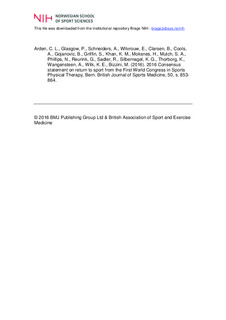| dc.contributor.author | Ardern, Clare L. | |
| dc.contributor.author | Glasgow, Philip | |
| dc.contributor.author | Schneiders, Anthony | |
| dc.contributor.author | Witvrouw, Erik | |
| dc.contributor.author | Clarsen, Benjamin Matthew | |
| dc.contributor.author | Cools, Ann | |
| dc.contributor.author | Gojanovic, Boris | |
| dc.contributor.author | Griffin, Steffan | |
| dc.contributor.author | Khan, Karim M. | |
| dc.contributor.author | Moksnes, Håvard | |
| dc.contributor.author | Mutch, Stephen A. | |
| dc.contributor.author | Phillips, Nicola | |
| dc.contributor.author | Reurink, Gustaaf | |
| dc.contributor.author | Sadler, Robin | |
| dc.contributor.author | Silbernagel, Karin Grävare | |
| dc.contributor.author | Thorborg, Kristian | |
| dc.contributor.author | Wangensteen, Arnlaug | |
| dc.contributor.author | Wilk, Kevin E. | |
| dc.contributor.author | Bizzini, Mario | |
| dc.date.accessioned | 2017-01-27T12:45:02Z | |
| dc.date.available | 2017-01-27T12:45:02Z | |
| dc.date.issued | 2016 | |
| dc.identifier.citation | British Journal of Sports Medicine. 2016, 50, 853-864 | nb_NO |
| dc.identifier.uri | http://hdl.handle.net/11250/2428778 | |
| dc.description | Copyright © 2017 BMJ Publishing Group | nb_NO |
| dc.description.abstract | Deciding when to return to sport after injury is complex and multifactorial—an exercise in risk management. Return to sport decisions are made every day by clinicians, athletes and coaches, ideally in a collaborative way. The purpose of this consensus statement was to present and synthesise current evidence to make recommendations for return to sport decision-making, clinical practice and future research directions related to returning athletes to sport. A half day meeting was held in Bern, Switzerland, after the First World Congress in Sports Physical Therapy. 17 expert clinicians participated. 4 main sections were initially agreed upon, then participants elected to join 1 of the 4 groups—each group focused on 1 section of the consensus statement. Participants in each group discussed and summarised the key issues for their section before the 17-member group met again for discussion to reach consensus on the content of the 4 sections. Return to sport is not a decision taken in isolation at the end of the recovery and rehabilitation process. Instead, return to sport should be viewed as a continuum, paralleled with recovery and rehabilitation. Biopsychosocial models may help the clinician make sense of individual factors that may influence the athlete's return to sport, and the Strategic Assessment of Risk and Risk Tolerance framework may help decision-makers synthesise information to make an optimal return to sport decision. Research evidence to support return to sport decisions in clinical practice is scarce. Future research should focus on a standardised approach to defining, measuring and reporting return to sport outcomes, and identifying valuable prognostic factors for returning to sport. | nb_NO |
| dc.language.iso | eng | nb_NO |
| dc.publisher | BMJ Publishing Group | nb_NO |
| dc.subject | consensus statement | nb_NO |
| dc.subject | sports | nb_NO |
| dc.subject | sports and exercise medicine | nb_NO |
| dc.subject | sports physiotherapy | nb_NO |
| dc.title | 2016 Consensus statement on return to sport from the First World Congress in Sports Physical Therapy, Bern | nb_NO |
| dc.type | Journal article | nb_NO |
| dc.type | Peer reviewed | nb_NO |
| dc.subject.nsi | VDP::Samfunnsvitenskap: 200::Samfunnsvitenskapelige idrettsfag: 330::Andre idrettsfag: 339 | nb_NO |
| dc.source.journal | British Journal of Sports Medicine | nb_NO |
| dc.identifier.doi | 10.1136/bjsports-2016-096278 | |
| dc.description.localcode | Seksjon for idrettsmedisinske fag / Department of Sports Medicine | nb_NO |
